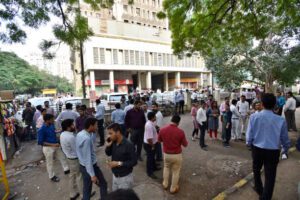Why Delhi tremors frequently on earthquake in neighbouring areas

Delhi-NCR falls in the Seismic Zone-IV, which is considered a high seismic risk zone according to the Bureau of Indian Standards (BIS) seismic zoning map. (Photo: AFP)For the third time in a month, Delhi-NCR residents felt tremors after a 6.4 magnitude quake jolted Nepal. But why is the national capital experiencing tremors so frequently?
- 2013 – 1
- 2014- 1
- 2015 – 3
- 2016 – 5
- 2017 – 5
- 2018 -4
- 2019 -3
- 2020 -9
- 2021 – 2
- 2022 -5
- 2023 – 5 till now
This is huge alarm to India and People living in Delhi .
As per reports , Delhi and the National Capital Region (NCR) fall in the Seismic Zone-IV, which is considered a high seismic risk zone according to the Bureau of Indian Standards (BIS) seismic zoning map. Zone IV signifies a higher likelihood of experiencing earthquakes with moderate to high levels of intensity.
WHAT IS SEISMIC ZONE-IV AND WHY IT IS VULNERABLE TO FREQUENT TREMORS?
Seismic Zone 4 is at high risk for earthquakes with an intensity of Medvedev-Sponheuer-Karnik (MSK) VIII. The MSK scale is a macro-seismic intensity scale used to evaluate ground shaking based on observed effects in an earthquake area .This categorisation is mainly due to geographical position and geological activities. Delhi is situated in close proximity to the Himalayan ranges, roughly between 200-300 kilometres. The Himalayas were formed due to the continual collision of the Indian and Eurasian tectonic plates. This constant tectonic activity results in regular tremors, making the region an epicentre for recurring natural calamities like earthquakes and landslides.
The region’s seismic risk is primarily associated with the proximity to the Himalayan tectonic plate boundary, which is where the Indian plate collides with the Eurasian plate. The collision is responsible for the significant seismic activity in northern India, including Delhi and its neighbouring areas. While Delhi itself is not situated on a major fault line, it is located in a seismically active region due to its proximity to the Himalayas.
Hence, Nepal, Uttarakhand and the adjoining Himalayan region are susceptible to a devastating earthquake with an intensity of more than 8.5 on the Richter Scale. The proximity to the Himalayas is one of the factors why Delhi has been kept in Zone IV while the Himalayan region falls under Zone V, the highest risk of damaging earthquakes.
UNIQUE SETTLEMENT PATTERN
Aside from geological factors, the unique settlement pattern of Delhi and NCR contributes to the vulnerability. The region is characterised by vast high-rise constructions and sprawling informal settlements. Areas along the banks of the Yamuna and Hindon rivers, where numerous multi-story buildings are located, reside in the most seismic-prone zones. Even sections of Old Delhi and unauthorised colonies on the riverbanks add to this vulnerability.
Experts have warned about the potential for a significant earthquake in the region in the future. The consequences of a major earthquake in Delhi could be severe, given the densely populated urban area, ageing infrastructure, and inadequate building standards in some parts of the national capital.
However, it’s important to note that earthquakes are complex and difficult to predict with precision. While experts can assess the seismic hazard in a region and provide warnings and recommendations, the exact timing and magnitude of future earthquakes remain uncertain.
The government and local authorities have been working to improve earthquake preparedness, update building codes and retrofit critical infrastructure to mitigate the risks associated with seismic activity.
However, it’s important to note that earthquakes are complex and difficult to predict with precision. While experts can assess the seismic hazard in a region and provide warnings and recommendations, the exact timing and magnitude of future earthquakes remain uncertain.
‘EVACUATION DRILLS NEEDED’
Former special CEO of Delhi Disaster Management Authority (DDMA) Kuldeep Singh Gangar believes that more disaster mock drills should be held regularly to educate people in the event of a natural disaster.
“Despite Delhi being under continuous threat of a potential major earthquake, we are not quite well prepared. The disaster management mock drills should be a routine affair to educate the people when such a natural disaster knocks on our doors. Disaster special forces should be in place to fight such emergencies,
2 thoughts on “Why Delhi tremors frequently on earthquake in neighbouring areas”